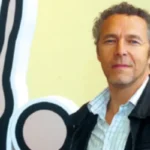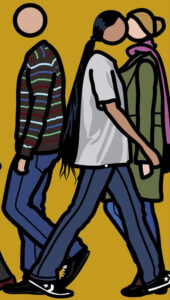Artist Julian Opie draws inspiration from the contemporary world, constructing his refined, concise visual language, through which images of people, figures and landscapes are conjured, and rendering them in his universally recognizable style. He uses simple signs and pictograms and expands them to evoke real people and places. His work, derived in part from Patrick Caulfield and Michael Craig-Martin, involves the reduction of photographs (or short films) into figurative reproductions using computer software.
In his portraiture, the human face is characterized by black outlines with flat areas of color, and mineralized detail, to the extent that an eye can become just the black circle of the pupil, and sometimes a head is represented by a circle with a space where the neck would be. He represents mundane activities through simple reductions. Opie also uses sculpture and light installations to present items of everyday existence. Through his online store, JulianOpeShop.com, the artist reflects upon his ambition to break down the barriers between what is deemed to be ‘fine art’ and ‘everyday’.
Opie was born in 1958 in London and graduated in 1983 from Goldsmiths School of Art, where he was taught by Michael Craig-Martin. His style was brought into the public eye when he was asked to design the cover for the British band, Blur's best of album, where the band members, Graham Coxon, Alex James, Dave Rowntree and Damon Albarn were transformed in typical Opie style. He has presented works at numerous public spaces around the world, notably the Dentsu Building in Tokyo; City Hall Park in New York, Phoenix Art Museum in USA; Dublin City Gallery in Ireland; Seoul Square in South Korea; Regent’s Place in London and most recently permanent installations at SMETS in Belgium, PKZ in Zurich, Arendt and Medernach in Luxembourg. Opie’s works can be found in many public art collections, including Tate, British Museum, Victoria & Albert, Arts Council, British Council and National Portrait Gallery in London, The Museum of Modern Art in New York, ICA in Boston USA, Essl Collection in Vienna, IVAM in Spain, The Israel Museum in Jerusalem and Takamatsu City Museum of Art in Japan.
Opie lives and works in London.
In his portraiture, the human face is characterized by black outlines with flat areas of color, and mineralized detail, to the extent that an eye can become just the black circle of the pupil, and sometimes a head is represented by a circle with a space where the neck would be. He represents mundane activities through simple reductions. Opie also uses sculpture and light installations to present items of everyday existence. Through his online store, JulianOpeShop.com, the artist reflects upon his ambition to break down the barriers between what is deemed to be ‘fine art’ and ‘everyday’.
Opie was born in 1958 in London and graduated in 1983 from Goldsmiths School of Art, where he was taught by Michael Craig-Martin. His style was brought into the public eye when he was asked to design the cover for the British band, Blur's best of album, where the band members, Graham Coxon, Alex James, Dave Rowntree and Damon Albarn were transformed in typical Opie style. He has presented works at numerous public spaces around the world, notably the Dentsu Building in Tokyo; City Hall Park in New York, Phoenix Art Museum in USA; Dublin City Gallery in Ireland; Seoul Square in South Korea; Regent’s Place in London and most recently permanent installations at SMETS in Belgium, PKZ in Zurich, Arendt and Medernach in Luxembourg. Opie’s works can be found in many public art collections, including Tate, British Museum, Victoria & Albert, Arts Council, British Council and National Portrait Gallery in London, The Museum of Modern Art in New York, ICA in Boston USA, Essl Collection in Vienna, IVAM in Spain, The Israel Museum in Jerusalem and Takamatsu City Museum of Art in Japan.
Opie lives and works in London.

Shows
 Back
Back









